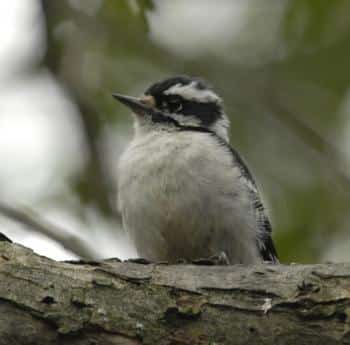Don’t Hole Up All Winter

Downy woodpecker
Photo credit: Jim Williams
by Clay Christensen
Contributing Writer
Each year as I get older I seem to think more soberly about the approaching winter: the cold, the ice, the winds, the short days and the long nights. I think part of my dread is that it’s a reminder of the brevity of life in general, and my life in particular.
Last year, I got a welcome relief from my malaise, and it came from an unexpected source: one of our most common birds during what I expected to be a rather mundane field trip.
In late September ’09, I was one of several birders who volunteered to take some Como Park High School kids on a bird walk in the Como Woods. It was a windy day with the threat of rain, a gloomy day that matched my mood.
Then, about 10 minutes into our walk, we saw a rather ordinary bird that became an inspiration to me. It was a male downy woodpecker that we found high up on a dead snag.
There on that limb-less tree, it was perched just below a perfectly round hole. He sat still for a bit and then went headfirst into the hole until just the tip of his tail poked out.
After a moment or two, he backed himself out again. He was working on this hole. Woodpecker holes turn downward after the initial entrance tunnel, so he was excavating in a head-down position.
What was he up to? Fall isn’t the right time of the year for nest-building, so this was probably going to be a roost hole. The entrance hole faced away from the predominating winds. Several of our woodpecker species don’t migrate, or go only very short distances. If they’ve found an area with a decent winter food supply and shelter, they’ll generally stay put.
Woodpeckers usually sleep alone in a cavity at night and generally make several of them. Why? Because they compete with chickadees, nuthatches, and other woodpeckers who are perfectly happy to squat for the night in a woodpecker roost hole.
You can imagine, just as winter dusk is falling, flying up to one of your favorite roost holes. You stick your head in, and Whammo! an aggressive beak is thrust at your face. Cavity roosting can be a hazardous prospect.
Woodpeckers don’t hole up for the entire winter. They spend their nights in a roosting cavity, but on most days, they’re out searching for grubs and other food.
As I was watching this little male downy woodpecker, I realized that he was teaching me something. He was preparing for winter, for what he knew would be cold nights ahead, but he was also certainly too busy to worry about dreading it.
That industrious little downy was teaching me not to waste time and energy dreading the inevitable. Even though I could ponder mortality while he could not, I was no different from the woodpecker. Pondering mortality doesn’t give one any special coping skills.
When faced with the inevitable, there is only one thing that any of us can do: Prepare for it, plan for it, as best as you’re able, and then face it squarely. My malaise was lifted and in its place was a resolution to prepare, plan and face winter squarely.
Since last year, I’ve been getting out to do some birding weekly with a small group of friends, usually despite the weather. That keeps my spirits up and helps me face winter with a sense of hope (hope it doesn’t last too much longer!).
Clay Christensen writes The Birdman of Lauderdale column which appears in the St. Anthony Park “Bugle,” where a version of this article first appeared.



